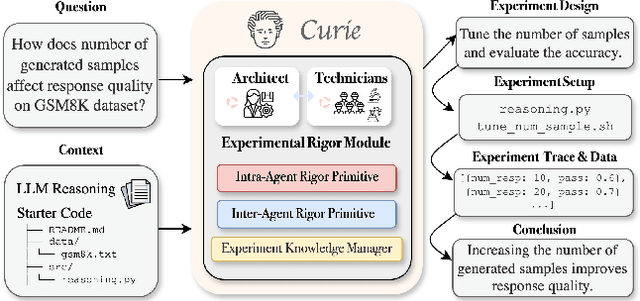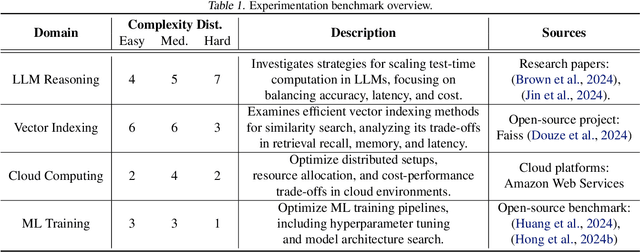Myungjin Lee
SuperGen: An Efficient Ultra-high-resolution Video Generation System with Sketching and Tiling
Aug 25, 2025Abstract:Diffusion models have recently achieved remarkable success in generative tasks (e.g., image and video generation), and the demand for high-quality content (e.g., 2K/4K videos) is rapidly increasing across various domains. However, generating ultra-high-resolution videos on existing standard-resolution (e.g., 720p) platforms remains challenging due to the excessive re-training requirements and prohibitively high computational and memory costs. To this end, we introduce SuperGen, an efficient tile-based framework for ultra-high-resolution video generation. SuperGen features a novel training-free algorithmic innovation with tiling to successfully support a wide range of resolutions without additional training efforts while significantly reducing both memory footprint and computational complexity. Moreover, SuperGen incorporates a tile-tailored, adaptive, region-aware caching strategy that accelerates video generation by exploiting redundancy across denoising steps and spatial regions. SuperGen also integrates cache-guided, communication-minimized tile parallelism for enhanced throughput and minimized latency. Evaluations demonstrate that SuperGen harvests the maximum performance gains while achieving high output quality across various benchmarks.
Towards Decentralized and Sustainable Foundation Model Training with the Edge
Jul 02, 2025Abstract:Foundation models are at the forefront of AI research, appealing for their ability to learn from vast datasets and cater to diverse tasks. Yet, their significant computational demands raise issues of environmental impact and the risk of centralized control in their development. We put forward a vision towards decentralized and sustainable foundation model training that leverages the collective compute of sparingly used connected edge AI devices. We present the rationale behind our vision, particularly in support of its sustainability benefit. We further outline a set of challenges that need to be addressed to turn this vision into reality.
A Collaborative Process Parameter Recommender System for Fleets of Networked Manufacturing Machines -- with Application to 3D Printing
Jun 13, 2025Abstract:Fleets of networked manufacturing machines of the same type, that are collocated or geographically distributed, are growing in popularity. An excellent example is the rise of 3D printing farms, which consist of multiple networked 3D printers operating in parallel, enabling faster production and efficient mass customization. However, optimizing process parameters across a fleet of manufacturing machines, even of the same type, remains a challenge due to machine-to-machine variability. Traditional trial-and-error approaches are inefficient, requiring extensive testing to determine optimal process parameters for an entire fleet. In this work, we introduce a machine learning-based collaborative recommender system that optimizes process parameters for each machine in a fleet by modeling the problem as a sequential matrix completion task. Our approach leverages spectral clustering and alternating least squares to iteratively refine parameter predictions, enabling real-time collaboration among the machines in a fleet while minimizing the number of experimental trials. We validate our method using a mini 3D printing farm consisting of ten 3D printers for which we optimize acceleration and speed settings to maximize print quality and productivity. Our approach achieves significantly faster convergence to optimal process parameters compared to non-collaborative matrix completion.
EXP-Bench: Can AI Conduct AI Research Experiments?
May 30, 2025



Abstract:Automating AI research holds immense potential for accelerating scientific progress, yet current AI agents struggle with the complexities of rigorous, end-to-end experimentation. We introduce EXP-Bench, a novel benchmark designed to systematically evaluate AI agents on complete research experiments sourced from influential AI publications. Given a research question and incomplete starter code, EXP-Bench challenges AI agents to formulate hypotheses, design and implement experimental procedures, execute them, and analyze results. To enable the creation of such intricate and authentic tasks with high-fidelity, we design a semi-autonomous pipeline to extract and structure crucial experimental details from these research papers and their associated open-source code. With the pipeline, EXP-Bench curated 461 AI research tasks from 51 top-tier AI research papers. Evaluations of leading LLM-based agents, such as OpenHands and IterativeAgent on EXP-Bench demonstrate partial capabilities: while scores on individual experimental aspects such as design or implementation correctness occasionally reach 20-35%, the success rate for complete, executable experiments was a mere 0.5%. By identifying these bottlenecks and providing realistic step-by-step experiment procedures, EXP-Bench serves as a vital tool for future AI agents to improve their ability to conduct AI research experiments. EXP-Bench is open-sourced at https://github.com/Just-Curieous/Curie/tree/main/benchmark/exp_bench.
Tempo: Application-aware LLM Serving with Mixed SLO Requirements
Apr 24, 2025



Abstract:The integration of Large Language Models (LLMs) into diverse applications, ranging from interactive chatbots and cloud AIOps to intelligent agents, has introduced a wide spectrum of Service Level Objectives (SLOs) for responsiveness. These workloads include latency-sensitive requests focused on per-token latency in streaming chat, throughput-intensive requests that require rapid full responses to invoke tools, and collective requests with dynamic dependencies arising from self-reflection or agent-based reasoning. This workload diversity, amplified by unpredictable request information such as response lengths and runtime dependencies, makes existing schedulers inadequate even within their design envelopes. In this paper, we define service gain as the useful service delivered by completing requests. We observe that as SLO directly reflects the actual performance needs of requests, completing a request much faster than its SLO (e.g., deadline) yields limited additional service gain. Based on this insight, we introduce Tempo, the first systematic SLO-aware scheduler designed to maximize service gain across diverse LLM workloads. Tempo allocates just enough serving bandwidth to meet each SLO, maximizing residual capacity for others best-effort workloads. Instead of assuming request information or none at all, it adopts a hybrid scheduling strategy: using quantile-based response upper bounds and dependency-graph matching for conservative initial estimates, prioritizing requests by service gain density, and refining decisions online as generation progresses. Our evaluation across diverse workloads, including chat, reasoning, and agentic pipelines, shows that Tempo improves end-to-end service gain by up to 8.3$\times$ and achieves up to 10.3$\times$ SLO goodput compared to state-of-the-art designs
Prada: Black-Box LLM Adaptation with Private Data on Resource-Constrained Devices
Mar 19, 2025Abstract:In recent years, Large Language Models (LLMs) have demonstrated remarkable abilities in various natural language processing tasks. However, adapting these models to specialized domains using private datasets stored on resource-constrained edge devices, such as smartphones and personal computers, remains challenging due to significant privacy concerns and limited computational resources. Existing model adaptation methods either compromise data privacy by requiring data transmission or jeopardize model privacy by exposing proprietary LLM parameters. To address these challenges, we propose Prada, a novel privacy-preserving and efficient black-box LLM adaptation system using private on-device datasets. Prada employs a lightweight proxy model fine-tuned with Low-Rank Adaptation (LoRA) locally on user devices. During inference, Prada leverages the logits offset, i.e., difference in outputs between the base and adapted proxy models, to iteratively refine outputs from a remote black-box LLM. This offset-based adaptation approach preserves both data privacy and model privacy, as there is no need to share sensitive data or proprietary model parameters. Furthermore, we incorporate speculative decoding to further speed up the inference process of Prada, making the system practically deployable on bandwidth-constrained edge devices, enabling a more practical deployment of Prada. Extensive experiments on various downstream tasks demonstrate that Prada achieves performance comparable to centralized fine-tuning methods while significantly reducing computational overhead by up to 60% and communication costs by up to 80%.
Personalized Federated Fine-tuning for Heterogeneous Data: An Automatic Rank Learning Approach via Two-Level LoRA
Mar 05, 2025



Abstract:We study the task of personalized federated fine-tuning with heterogeneous data in the context of language models, where clients collaboratively fine-tune a language model (e.g., BERT, GPT) without sharing their local data, achieving personalization simultaneously. While recent efforts have applied parameter-efficient fine-tuning techniques like low-rank adaptation (LoRA) in federated settings, they typically use single or multiple independent low-rank adapters with predefined maximal and minimal ranks, which may not be optimal for diverse data sources over clients. To address this issue, we propose PF2LoRA, a new personalized federated fine-tuning algorithm built on a novel \emph{automatic rank learning approach via two-level LoRA}. Given the pretrained language model whose weight is frozen, our algorithm aims to learn two levels of adaptation simultaneously: the first level aims to learn a common adapter for all clients, while the second level fosters individual client personalization. A key advantage of PF2LoRA is its ability to adaptively determine a suitable rank based on an individual client's data, rather than relying on a predefined rank that is agnostic to data heterogeneity. We present a synthetic example that highlights how PF2LoRA automatically learns the ground-truth rank for each client, tailoring the adaptation to match the properties of their individual data. Notably, this approach introduces minimal additional memory overhead, as the second-level adaptation comprises a small number of parameters compared to the first level. Our experiments on natural language understanding and generation tasks demonstrate that PF2LoRA significantly outperforms existing federated fine-tuning methods.
Curie: Toward Rigorous and Automated Scientific Experimentation with AI Agents
Feb 26, 2025



Abstract:Scientific experimentation, a cornerstone of human progress, demands rigor in reliability, methodical control, and interpretability to yield meaningful results. Despite the growing capabilities of large language models (LLMs) in automating different aspects of the scientific process, automating rigorous experimentation remains a significant challenge. To address this gap, we propose Curie, an AI agent framework designed to embed rigor into the experimentation process through three key components: an intra-agent rigor module to enhance reliability, an inter-agent rigor module to maintain methodical control, and an experiment knowledge module to enhance interpretability. To evaluate Curie, we design a novel experimental benchmark composed of 46 questions across four computer science domains, derived from influential research papers, and widely adopted open-source projects. Compared to the strongest baseline tested, we achieve a 3.4$\times$ improvement in correctly answering experimental questions. Curie is open-sourced at https://github.com/Just-Curieous/Curie.
Prediction-Assisted Online Distributed Deep Learning Workload Scheduling in GPU Clusters
Jan 09, 2025



Abstract:The recent explosive growth of deep learning (DL) models has necessitated a compelling need for efficient job scheduling for distributed deep learning training with mixed parallelisms (DDLwMP) in GPU clusters. This paper proposes an adaptive shortest-remaining-processing-time-first (A-SRPT) scheduling algorithm, a novel prediction-assisted online scheduling approach designed to mitigate the challenges associated with DL cluster scheduling. By modeling each job as a graph corresponding to heterogeneous Deep Neural Network (DNN) models and their associated distributed training configurations, A-SRPT strategically assigns jobs to the available GPUs, thereby minimizing inter-server communication overhead. Observing that most DDLwMP jobs recur, A-SRPT incorporates a random forest regression model to predict training iterations. Crucially, A-SRPT maps the complex scheduling problem into a single-machine instance, which is addressed optimally by a preemptive "shortest-remaining-processing-time-first" strategy. This optimized solution serves as a guide for actual job scheduling within the GPU clusters, leading to a theoretically provable competitive scheduling efficiency. We conduct extensive real-world testbed and simulation experiments to verify our proposed algorithms.
ProFL: Performative Robust Optimal Federated Learning
Oct 23, 2024Abstract:Performative prediction (PP) is a framework that captures distribution shifts that occur during the training of machine learning models due to their deployment. As the trained model is used, its generated data could cause the model to evolve, leading to deviations from the original data distribution. The impact of such model-induced distribution shifts in the federated learning (FL) setup remains unexplored despite being increasingly likely to transpire in real-life use cases. Although Jin et al. (2024) recently extended PP to FL in a straightforward manner, the resulting model only converges to a performative stable point, which may be far from optimal. The methods in Izzo et al. (2021); Miller et al. (2021) can find a performative optimal point in centralized settings, but they require the performative risk to be convex and the training data to be noiseless, assumptions often violated in realistic FL systems. This paper overcomes all of these shortcomings and proposes Performative robust optimal Federated Learning (ProFL), an algorithm that finds performative optimal points in FL from noisy and contaminated data. We present the convergence analysis under the Polyak-Lojasiewicz condition, which applies to non-convex objectives. Extensive experiments on multiple datasets validate our proposed algorithms' efficiency.
 Add to Chrome
Add to Chrome Add to Firefox
Add to Firefox Add to Edge
Add to Edge